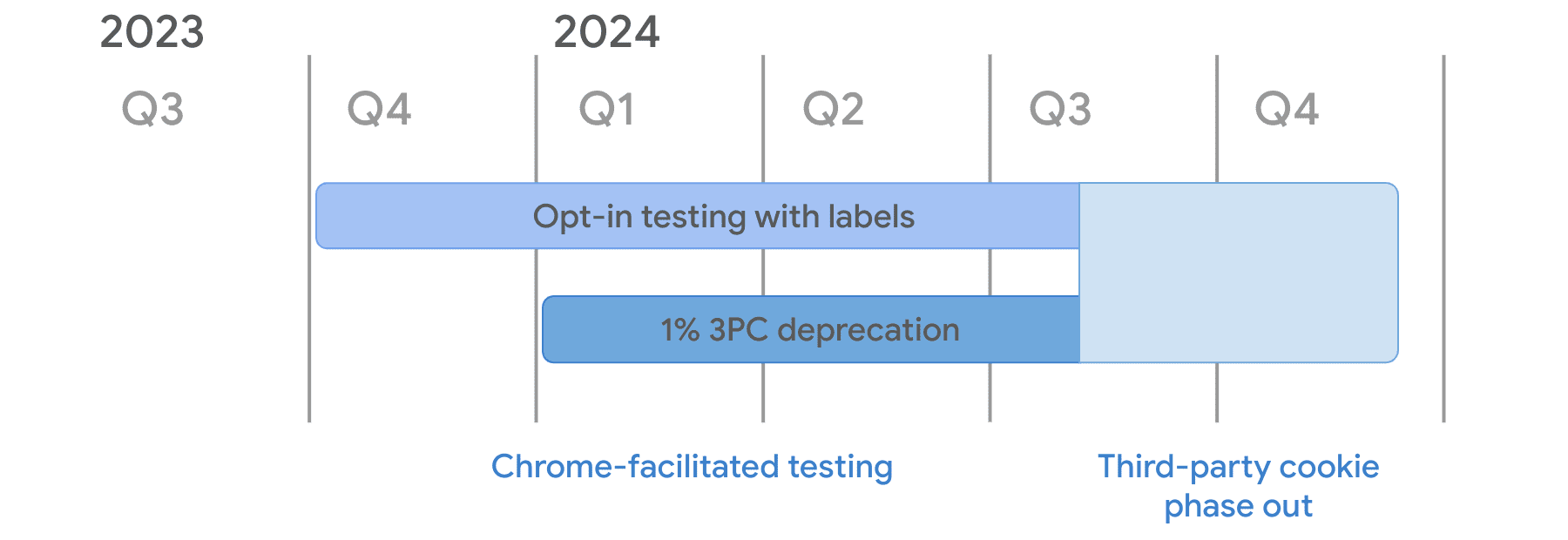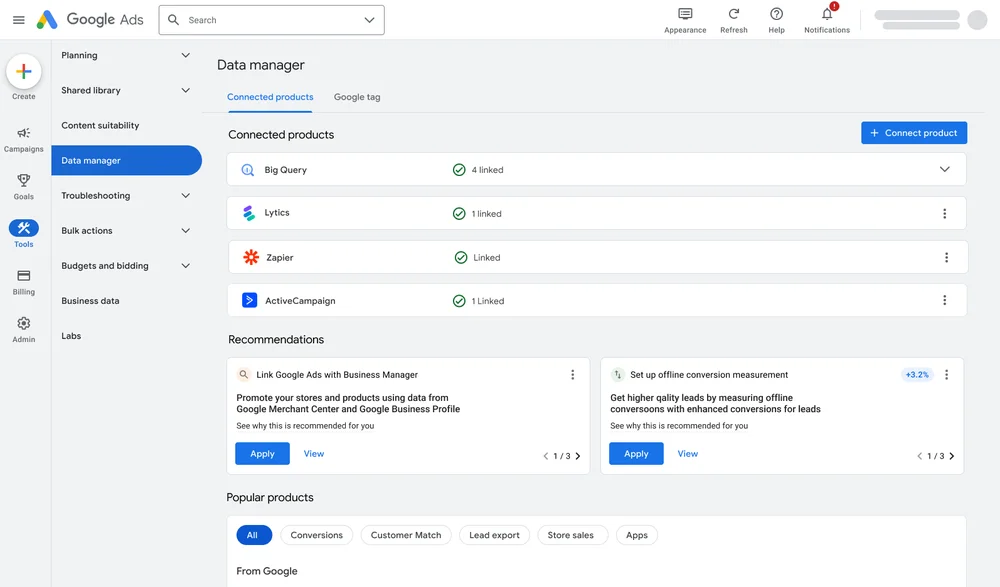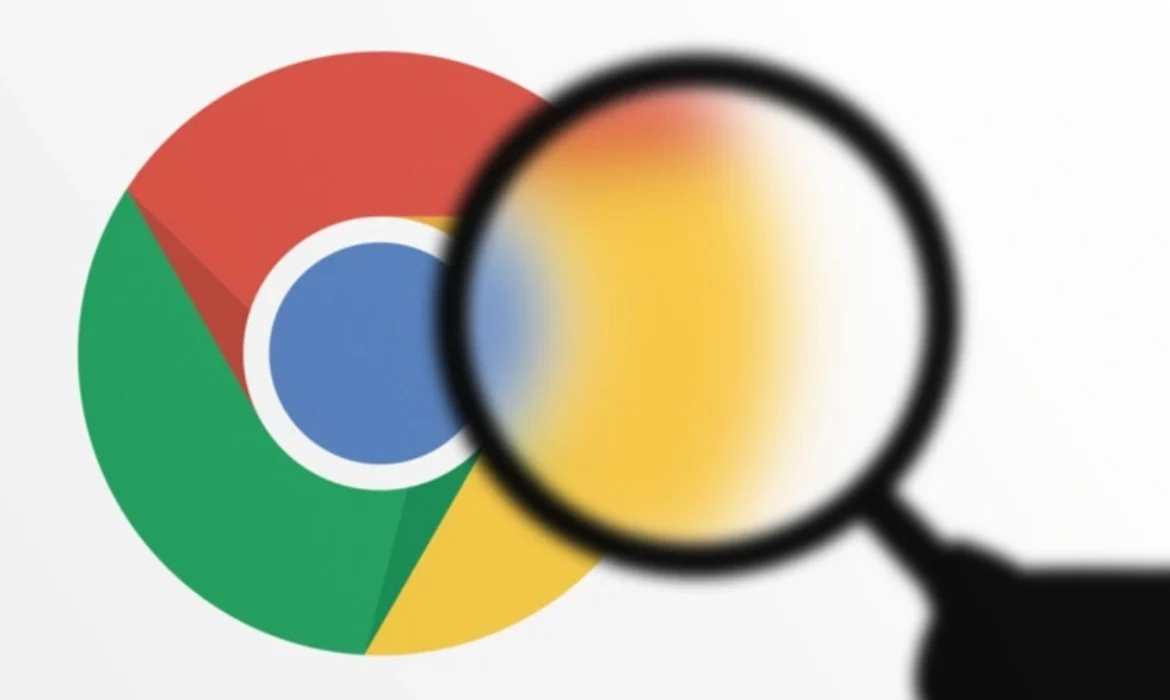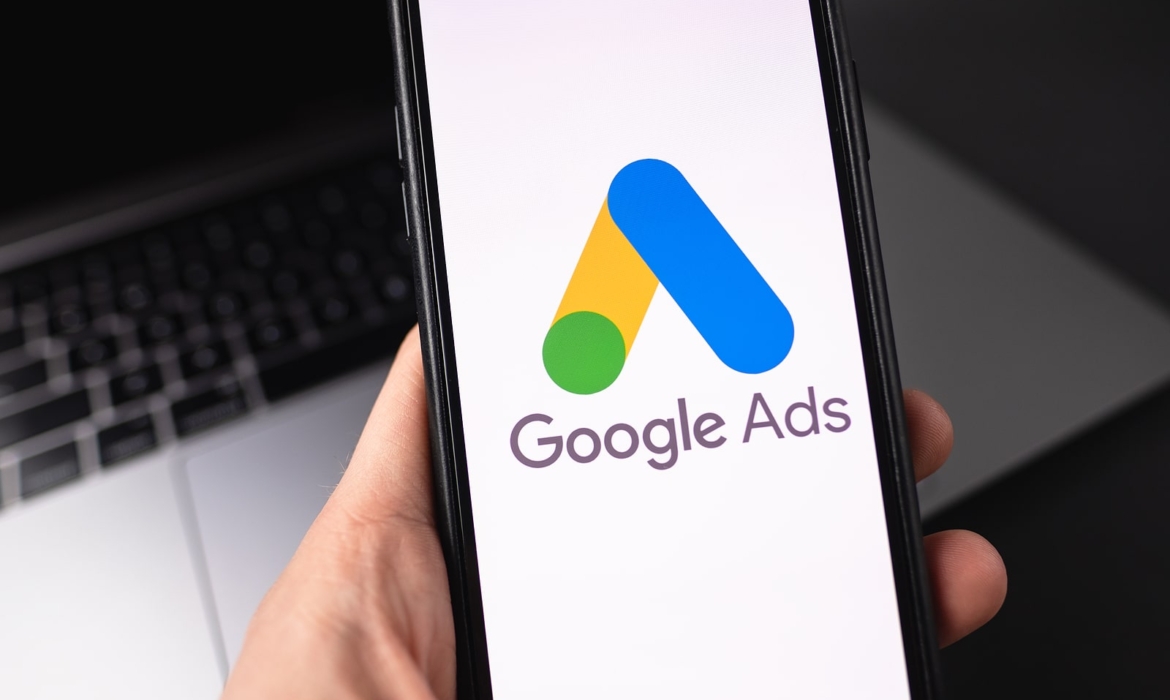Google’s Third-Party Cookies Deprecation Rolls Out Today
Cookies are the currency of the world of digital advertising. At least that’s how they were once. Now is the time to get ready to phase out third-party cookies and begin using cookie-less strategies. Making the switch to contextual advertising will now require getting ready for a world without cookies.
Beginning today, January 4, Google intends to remove third-party cookies from its Chrome browser by the end of 2024. With 1% of cookies impacted, the tech giant has planned a gradual phase-out that will begin today and give marketers time to adjust before the full removal by the end of the year. Publishers’ and advertisers’ interactions will undoubtedly change significantly as a result of the gradual removal of cookies. It represents a significant policy shift and a move towards privacy-focused transactions.
Google’s third-party cookies phase-out plans
As part of a pilot program, Google will begin gradually phasing out cookies for 1% of Chrome users starting today. To prepare for the big show, Google’s masterminds will observe, evaluate, test, and reorganize. Understanding the nature of the cookie-less environment and its practical implications will be greatly aided by this small-scale deprecation. Although Google did not immediately disclose the precise number of cookies for the impacted internet users, it is possible that up to 30 million cookies are in place. Despite being gradual and phased out, the phaseout would be finished by this year’s second half, most likely in Q3 2024. If regulations allow, Google intends to remove third-party cookies for all Chrome users.

Image credit- Google
A major shift in the advertising world
Google wanted to allow publishers and advertisers ample time to get ready. Thus, the delayed launch. This will compel significant adjustments to the way digital advertising functions. Some worry that it might force websites to use more obscure tracking methods. Given how heavily the digital advertising sector depends on third-party cookie tracking, the news is probably going to cause controversy. Certain ad tech companies may lose their present capacity to gather data. Rather than being genuinely excited, the advertising industry’s anticipation can best be described as cautious skepticism. It is independent of the segment of the advertising business, be it browsers or ad tech providers.
Origin of third-party cookies
Originally, the goal of third-party cookies was to provide website users with more specialized advertisements. Rather, they evolved into something that was frequently centered on obsolete consumer behavior. To generate behavioral profiles, cookies were combined. Because of retargeting and open conversion loops, website users would still see ads for items they had previously browsed six months ago.
Read More: Google’s Phasing Out of Third-Party Cookies: A Paradigm Shift in Digital Advertising
How does the advertising world perceive this?
At the moment, the Privacy Sandbox is not a problem for any ad tech providers. Some vendors may view the partnership with Sandbox as a calculated move to remain relevant and competitive in light of Google’s strong market position. This decision was made easier by the testing grants Google is providing. That being said, some businesses aren’t as welcoming. They are unwilling to support the Sandbox as long as they believe it will further reinforce Google’s supremacy over the advertising industry.
With this first rollout, advertisers, publishers, and creators should take advantage of the chance to test and modify their strategies to effectively adjust to this change. Although the digital advertising industry has had nearly four years to plan, it is now necessary to develop flexible and adaptive approaches to determine what works and what doesn’t.
Important Alternatives to Cookies
It’s safe to say that there are a lot of interesting and complicated third-party cookie alternatives available. Shifts on this scale leave alternative identities in a constant state of change. They face difficulties with privacy compliance, interoperability, and measurement and targeting efficacy. Even the front-runners struggle with personal issues.
First-party cookies
To get ready for a world without cookies, advertisers need to gradually wean themselves off third-party data. To address this, first-party data-based solutions must be adopted, enabling advertisers to use their own, consenting user data for targeting. Instead of cookies, publishers and advertisers are experimenting with several first-party data-based solutions.
In the world of digital advertising, first-party cookies are a tactical turning point. Because they are site-specific, these cookies are ideal for meeting the requirements and preferences of different publishers and websites. Everything is connected to Google’s Privacy Sandbox program. The main focus of this large-scale project is privacy compliance. It seeks to satisfy cross-site use cases without using third-party cookies or other tracking mechanisms while balancing the needs of digital advertising with the privacy of individuals.

Image credit- Campaign Asia
Hashed emails
User email addresses are necessary for a hashed email solution to work. A user provides a wealth of identity and online behavioral data when they log in with their email address. This crucial information, which is now hidden by an encrypted identifier can be shared further up the chain with media buyers for more precise targeting. It can be pushed through a hashed email API and ensures that user data is fully secure. Ad tech companies first proposed hashed emails as a substitute for third-party cookies.
Read More: Yahoo Partners with VIOOH for prDOOH and Twilio for First-Party Ad Reach
Contextual data
One more of these alternative methods for third-party cookies is to use contextual data, which provides perspective about an online user rather than presumptive behavior. Contextual data assists advertisers in making decisions based on the content a user is currently consuming rather than previous behavior in this way. In addition to being frequently more effective, contextual data is also less expensive to obtain than third-party data. Generally speaking, contextual ad impressions are less expensive than behavioral ones. Given that the targeting is based on context and recency rather than legacy behavior, it can also aid in providing a better user experience.
APIs
Google is testing APIs. These include the “first locally executed decisions over groups experiment” (FLEDGE) and the Topics API, which have taken the place of the Privacy Sandbox’s initial federated learning of cohorts (FLoC) proposal. After analyzing a user’s three weeks of content consumption in an anonymous manner, Topics creates five “Topics” every week, one of which is sent in response to an ad request. The FLEDGE API auctions don’t rely on following users around websites because they operate directly within Chrome.
Retail Media Networks
Another cookie-less option that has emerged is retail media networks. Through these platforms, advertisers can reach more niche audiences and gain access to first-party data, including loyalty and point-of-sale data. By expanding the scope of this first-party data outside of the retailer’s owned and operated properties, RMNs assist advertisers in reaching in-market consumers without the need for cookies.
Chartering the course in the future.
The ad tech industry has entered uncharted territory with Google’s third-party deprecation. Everyone is wondering what the world will look like when the last third-party cookie disappears. There’s no denying that this ushers in a new era of digital advertising where privacy is crucial. Publishers will need to adjust to first-party cookies and other practices like hashed emails, and advertisers will move toward more content-based and contextual approaches.
Businesses of all sizes will need to be inventive and flexible to succeed in this new era. This entails making investments in fresh platforms and technologies that can adapt to the change and create new opportunities for efficient audience targeting without compromising user privacy. It’s not all bad news, though. A plethora of prospects lie ahead of us. Recall that in the cookie-less future, flexibility is essential.
Read More: GroupM and Google Announce Post Third-Party Cookie Readiness Program
Google Plans to Phase-Out Chrome Third Party Cookies On January 4, 2024
Google revealed that, as part of a plan to phase out third-party cookies, which marketers use to track users, it will start testing a new feature on its Chrome browser. From January 4th, the tech giant will begin its much-awaited purging of the internet’s cookies. It will block them for 1% of Chrome users, or roughly 30 million people. Users will notice a small eyeball logo in the URL bar when Tracking Protection is enabled. In the event of disruption, they will be prompted to deactivate Tracking Protection for particular websites. They will also be given the option to disable it altogether. This marks a significant milestone in Google’s Privacy Sandbox project. The initiative seeks to replace cookies with what it claims is a more effective form of tracking for efficient user privacy.
Google finally intends to phase out third-party cookies
In the second half of 2024, Google intends to fully phase out the use of third-party cookies for users. This marks a significant first step in Google’s Privacy Sandbox Initiative. It aims to replace cookies with an alternative tracking mechanism called “Tracking Protection,” which Google assets in a more privacy-oriented manner. The initiative comes nearly four years after third-party cookies were disabled in Firefox and Safari.
However, the timeline is contingent upon resolving antitrust issues brought forth by the Competition and Markets Authority (CMA) of the United Kingdom. In addition to keeping an eye on the company’s largest revenue stream, advertising, the CMA has been looking into Google’s proposal to stop supporting some cookies in Chrome. This is because the watchdog is concerned it will hinder competition in the digital advertising space.
Read More: Google’s Phasing Out of Third-Party Cookies: A Paradigm Shift in Digital Advertising
How were third-party cookies beneficial to advertisers?
Cookies are unique files that let websites and advertisers track a user’s browsing behavior and identify them individually. Advertisers claim that the removal of cookies from the most widely used browsers in the world will restrict their capacity to gather data for customized advertisements and force them to rely more on Google’s user databases. Online organizations have used third-party cookies as their main method of tracking users’ activities for decades. These cookies give websites the ability to work with different businesses, like Google, to track users’ online activities. A significant change in digital tracking tactics is reflected in the impending demise of third-party cookies.
So-called “third-party cookies” have been the main method used by websites and tech companies to track users online for the past 30 years. For example, after a user has added shoes to their cart, they will see online advertisements for those shoes over time. Third-party cookies come into play here. These cookies enable websites to collaborate with numerous businesses, such as Google, to monitor user activity on the internet. Although it is fantastic for businesses, the fact that so many companies can retain user browsing history is terrible for user privacy.
Privacy Sandbox Initiative
Google stated that users can use the symbol to the right of the address bar to temporarily turn cookies back on for 90 days if necessary. It is incase if the website isn’t functioning properly without third-party cookies. If Chrome detects any problems with a website through indicators like repeated page refreshes, it will prompt the marketer to take this action. Chrome continues to track users, and it does so in a manner different from that of Firefox and Safari. However, the majority of users don’t bother switching browsers, and Google’s brand-new Chrome version is at least better for privacy as it discloses less information about the user’s online activities. As part of the Privacy Sandbox Initiative, Chrome users can choose to enable or disable cookie replacements. If users find the idea objectionable, they can still disable these tools through their browser’s settings.
Read More: End Of Third-Party Cookies, What Is There For Marketers: Takeaway!
Optional Tool to disable cookies
Google has added a new set of tools to the Chrome browser. These tools allow it to track users’ online activities in place of third-party cookies. Using this new strategy, users’ data is preserved on their devices by grouping them into discrete “Ad Topics.” Websites can request a user’s classified group but will not obtain personal data. This is different from traditional cookie-based tracking techniques. Websites can ask Google which categories users fall into. However, they will not be able to identify users precisely (at least not with cookies).
A strategic move aligning with rising user privacy concerns
Google’s strategic action is in line with an industry-wide trend toward enhancing user privacy. It is a result of increased regulatory scrutiny and consumer demand for stricter protection against unwanted data tracking and profiling. There will be some bugs because this is a significant alteration to the way the internet functions. Cookies are used for much more than just spying. They also store information about user logins, what they have in their carts, and many other useful features. Despite Google’s efforts to identify and remove malicious cookies, there will always be early failures
Read More: GroupM and Google Announce Post Third-Party Cookie Readiness Program
Google Launches Google Ads Data Manager for First-Party Data
Google has created an advertising measurement tool that integrates with first-party data from marketers. It is made to function without browser cookies and other data tools that use antiquated techniques to measure performance. The measurement tool, Google Ads Data Manager, will be made accessible in Google Ads from the beginning of 2024. As the business continues to simplify the administration and use of first-party data, the product plan calls for expanding it to additional Google platforms. The tool will make it easier to connect to and utilize first-party data. It centralizes all data management controls, allowing for more income and improved business outcomes.
Google Ads Data Manager for Advertisers
Less than one-third of marketers, according to Google, consistently and successfully access and integrate first-party data across channels. This issue is resolved by Google Ads Data Manager, which streamlines the administration of first-party data connections and the procedure for utilizing that data for commercial purposes. As the advertising business enters the new year and Google deprecates third-party cookies, advertisers will gain knowledge about integrating data sources and protecting consumer data privacy. When it launches, it will make it easier to enable improved conversions for leads and Customer Match from many partners while still maintaining the essential functionality of each service.

Image credit- Google
Read More: Google Opens Automatically Created Assets Publicly to Boost Efficiency
A number of data sources, such as customer relationship management (CRM) and customer data platforms (CDPs), will be able to be connected by advertisers. Along with marketing tools like Shopify Audiences, this will also incorporate data sources like ActiveCampaign and Pipedrive. If Google Ads Data Manager is a success, it will be simpler to track client interactions with the Google tag and off-website transactions. Instead of altering how Google’s products function, the platform makes it easier for advertisers to use them. Data utilization in marketing is easier because it requires little to no coding expertise.
Benefits of the first-party data measurement tool
Analysts can build new data links using a single collaborative interface. Additionally, marketers can use discrete data to track conversions to target customers with relevant adverts. Zapier and CDPs, such as Lytics, will also provide data sources through cloud-based data storage solutions. Google wants the platform to give users access to all types of data through a single collaborative interface. This will allow analysts to make new data linkages. Furthermore, it will enable marketers to use discrete data to track conversions or target people with appropriate ads
Read More: Samsung Ads and Epsilon Partner for First-Party Data Advancements
IAB Tech Lab Launches Two Working Groups for AI and Privacy Sandbox
IAB Tech Lab, an international body that develops technical standards for digital advertising, recently announced the formation of two innovative working groups. These organizations will be crucial in determining how advertising and digital media develop in the future. They are the Artificial Intelligence (AI) Subcommittee and the Privacy Sandbox Task Force. These duo-functioning groups will enhance AI in digital media and steer Chrome Browser’s Privacy Sandbox changes.
Background
Since its launch in 2019, the Chrome Privacy Sandbox has been extremely active. But Google Chrome says third-party cookies must be deleted by Q2 2022. However, the due date was advanced. Chrome third-party cookies are expected to perish in the second half of 2024. As the finish line keeps fading from view, it is becoming increasingly difficult for people to sustain their enthusiasm for post-cookie experimentation. But with the formation of the Privacy Sandbox Task Force, the IAB Tech Lab is on it. It will experiment with Chrome APIs and communicate its findings to the market. Below are some insights and goals that the AI and Privacy Sandbox working groups will look to fulfill.
Read More: Google’s Phasing Out of Third-Party Cookies: A Paradigm Shift in Digital Advertising
Privacy Sandbox Task Force
IAB Tech Lab established the Privacy Sandbox Task Force since the evolving Privacy Sandbox within Google’s Chrome browser represents a critical turning point for digital advertising. The specialist task force’s goal is to conduct a thorough technical and operational review of the upcoming Privacy Sandbox improvements and their implications for use cases in digital advertising.
The key objectives include:
Technical analysis
To comprehend the consequences for advertisers, publishers, and ad tech providers, the task force will explore the technical details of Google Chrome’s Privacy Sandbox enhancements. These will include the protected audience API and the Attribution Reporting API.
Operations Perspective
It will analyze operational changes that digital advertising stakeholders need to adjust to maintain consistency in the delivery, optimization, and measurement of digital ads.
Analysis of gaps
Using the Privacy Sandbox, it will analyze, comprehend, and document important advertising use cases that brands and publishers can benefit from. In addition, it will suggest improvements in order to fill any gaps.
Recommendations
To handle the changes the Chrome browser brings forth, it will provide practical advice and update current or propose new technological standards for the digital advertising ecosystem. Later this year, the Task Force will release its findings and suggestions for the industry.
Privacy Sandbox Task Force Members
All IAB Tech Lab members are invited to join the Privacy Sandbox Task Force. Moreover, participants from all international digital advertising stakeholders who have tested or studied the Privacy Sandbox proposals are encouraged to do so. In order to successfully navigate this enormous change in the advertising industry, collaborative engagement will be essential.
Read More: Advertisers Embrace Programmatic Advertising As Cookies Decline
Artificial Intelligence (AI) Subcommittee
The AI Subcommittee was established as a result of AI’s radical changes to the world of digital media. A small group of IAB Tech Lab Board members make up this subcommittee. It will focus on the fast-evolving AI technology and digital media landscape interface. The AI Subcommittee’s key objectives include:
Roadmap creation
Developing near-term, short-term, and long-term roadmap goals to address the effect of AI on the digital media ecosystem, with a preliminary focus on media companies.
Developing an ethical framework
By developing new technical frameworks and standards, it will address the ethical issues raised by the use of AI in the media. It will further ensure that user privacy protection, and content reliability and transparency.
Media Trends Analysis using AI
Doing a thorough investigation of AI-driven media trends, including deep-fake technologies, virtual reality, generative AI, and content recommendation algorithms.
AI Subcommittee Members
The AI Subcommittee is open only to IAB Tech Lab Board Members. It brings together data scientists, publisher executives, cryptographers, and technology leaders from publishers, agencies, and big tech platforms to work together on defining an informed, moral, and exciting future for AI in digital media.
Here’s what they said
Anthony Katsur, CEO of IAB Tech Lab said,
Given their worldwide market share of approximately 65%, understanding the shifts brought about by Chrome’s Privacy Sandbox development is crucial. AI is not just a technological tool; it’s a force reshaping our media landscape. Its impact extends across content creation, distribution, consumption, consumer privacy, and monetization. The AI Subcommittee is poised to assume a vital role in comprehending and directing Tech Lab’s AI roadmap to manage this evolution.
About IAB Technology Laboratory
The IAB Technologies Laboratory (Tech Lab) is a non-profit organization founded in 2014. It collaborates with a member community on a global scale to create the fundamental standards and technologies necessary for the development of the digital media ecosystem’s growth and trust. Digital publishers, advertising technology companies, agencies, marketers, and other member organizations make up the IAB Tech Lab. Furthermore, it focuses on solutions for brand safety and ad fraud, identity, data, and consumer privacy, ad experiences and measurement, and programmatic efficacy. Project Rearc, an endeavor for privacy-centric addressability, the OpenRTB real-time bidding protocol, the ads.txt anti-fraud specification, the Open Measurement SDK for viewability and verification, the VAST video specification, and other work are among its accomplishments.
Read More: Publicis Media, UK AOP To Test Privacy-Enhancing Technology (PETs)
Google Prepares To Bring Privacy Sandbox Beta To Android
Google’s Privacy Sandbox features will start appearing on Android phones next year. The move will make it possible for stakeholders in the mobile advertising ecosystem to prepare for a future where targeting and attribution will be more restricted.
After developer previews of Privacy Sandbox for Android 13 have led to its entry into beta to allow developers to test “private advertising solutions on mobile”. Ad tech and app developers will be able to use this beta with privacy-preserving APIs that don’t share user data with third parties or use cross-party identifiers.
There’s rapid progress being made on the Android version of Privacy Sandbox. Upon the start of the beta, developers and ad tech companies will be able to test many Android privacy sandbox APIs – Topics, FLEDGE, attribution reporting, and SDK Runtime more seriously.
Interesting Read: Privacy Sandbox By Google Shows Backdoor To The Third-Party Cookies.
Testing API’s
The Chrome Privacy Sandbox is incubating, and testing the mobile app versions of the three ads-related APIs: Topics, FLEDGE, and the attribution API.
Topics are designed to preserve privacy while showing relevant content and ads, and FLEDGE allows for remarketing and custom audience use cases. Attribution API is readily comprehensible.
SDK(Software Development Kit) Runtime is unique to Android Privacy Sandbox. It provides enhanced safeguards and guarantees around user data collection. This is done through a modified execution environment which limits data access rights and the set of allowed permissions.
The SDK Runtime, which separates advertising SDKs included by applications, will have a closed beta for developers to test Runtime-enabled SDK distribution to select apps because of the coordination required to test the SDK Runtime.
According to Google’s current policy, developers of third-party SDKs, such as in-app measurement companies, can share the same permissions as Android app publishers. In the latest proposals, publisher partners submit their SDK, which Google reviews and then approves or rejects.
In a nutshell, ad tech companies and developers interested in testing the Android versions of Topics, FLEDGE, and the reporting attribution API must enroll and verify. As part of the beta early testers program, they will also have to fill out a form. However, SDK Runtime remains in closed beta for a select number of apps. The blog said,
“To utilize the Beta release, developers will need to compile their solutions with an API level 33 SDK extension update that is coming soon.”
How different is Google from Apple?
Despite the fact that Google seems like a more collaborative partner in mobile than Apple, there’s much debate about how the future of identity will unfold. Google has not yet announced a formal deadline for when Android AdID, the mobile equivalent of the cookie, will be deprecated. In contrast to Apple’s SKAD network, which advertisers and developers have found volatile and non-transparent, Google’s framework offers more granularity and capability to effectively measure and target ads.
Google plans to roll out the initial Privacy Sandbox Beta to Android 13 mobile devices in early 2023. It will “start with a small percentage of devices and increase over time.” During this time, developers will continue to get access to the latest features before they are released to the public. Google is working with ad tech and app developers offering advice to advertisers and publishers in the blog post,
“We’ve heard from many advertisers and publishers about the role they can play in testing these new technologies. For companies that rely on third party solutions for ad serving or ad measurement, we recommend working with your providers to understand their testing roadmaps and how you can participate in early testing of Privacy Sandbox.”
Interesting Read:Google Makes Final Settlement In Location Tracking By Paying USD 391 Million






